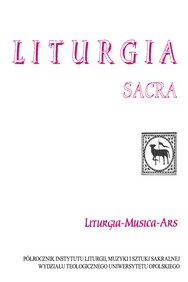Inspiracje gregoriańskie w Łatwej mszy polskiej w stylu choralnym ks. Brunona Schmidta (1895–1961)
Gregorian inspirations in The simple polish mass in a choral style by the Brunon Schmidt (1895–1961)
Author(s): Dariusz SobczakSubject(s): Christian Theology and Religion, Cultural history, Music, History of Church(es), Interwar Period (1920 - 1939)
Published by: Uniwersytet Opolski
Keywords: Gregorian chant; ordinarium missae; Gregorian inspirations; liturgy;
Summary/Abstract: The Rev. Brunon Schmidt was born in Poznań in 1895 (in the Prussian Partition). He took holy orders in the Gniezno Cathedral in 1921. From 1934 he was a parish priest in Łabiszyn. In the years 1934 and 1936 he published prayer-books written by himself. These prayerbooks contained the Litany of the Sacred Heart of Jesus and the Order of the Mass in Polish and in Latin. He was interested in liturgy and church singing. He composed ”The simple Polish mass in a choral style” under the pseudonym ”Brunon Poznańczyk”. Its printed version was probably issued in 1936 or 1937 and it was positively evaluated by the distinguished composer, Feliks Nowowiejski. The Rev. Schmidt tried to preserve in this composition the characteristics of Gregorian chant, such as lightness, free rhythmics, spirituality, calmness, and a smooth male voices’ cantilena. The mass by the Rev. Schmidt is divided into five parts: Kyrie, Gloria, Credo, Sanctus and Benedictus (forming a whole), Agnus Dei. Analyzing the melodics of this composition, it can be seen that some melodic themes were adopted by the Rev. Schmidt from the post-Gregorian Mass VIII ”De Angelis”. Judging by this composition written by the Rev. Brunon Schmidt, he appears a fine musician, liturgist and theologian. His ”The simple Polish mass in a choral style” referring to the Gregorian chant tradition is, at the same time, a pioneering work of the post conciliar period whose aim was to engage more music performers and all the faithful in the liturgy. In the 1960s this composition was made well-known in the Archidiocese of Gniezno by the Rev. Władysław Zientarski. Despite the passage of time, the free parts of the mass: Kyrie,
Journal: Liturgia Sacra
- Issue Year: XXVII/2021
- Issue No: 58
- Page Range: 161-177
- Page Count: 17
- Language: Polish

